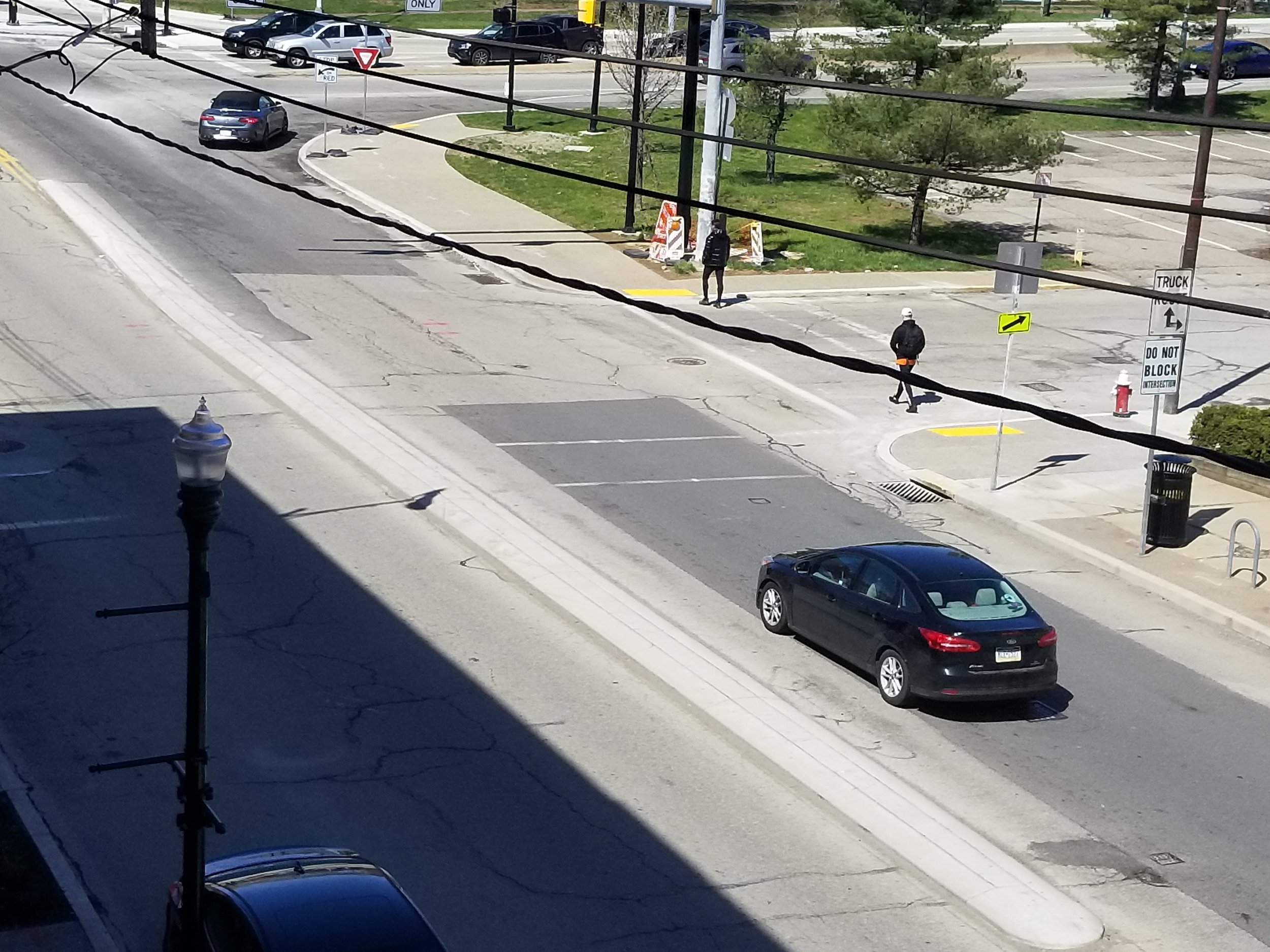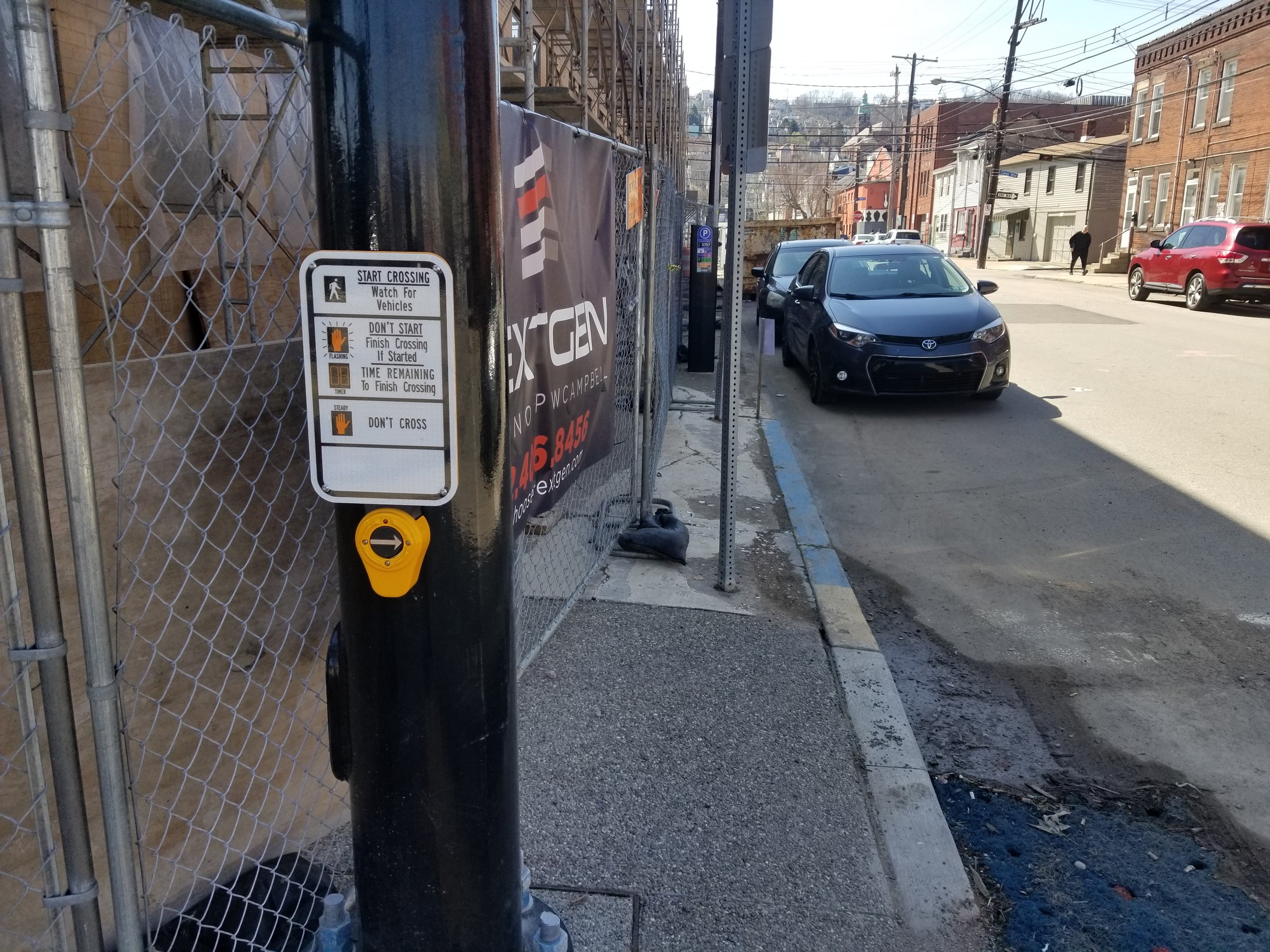Road Blocks: Mobility & Sidewalk Accessibility in Pittsburgh's South Side
When I moved to Pittsburgh’s South Side last summer I found it to be a dramatically different experience compared to my years living in the city’s East End neighborhoods. Most notably the entirety of South Side Flats seemed imminently accessible, with the major thoroughfare and commercial core of East Carson Street providing a walkable central corridor through the dense and dynamic neighborhood. I also immediately took advantage of the neighborhood’s unique mobility infrastructure including the nearby river trail, dedicated bike lanes, and ample neighborways. However, for the past several months more and more of my daily traversals through the neighborhood have featured scenes like the one pictured in the above photo.
Pennsylvania publications recently marked the beginning of “PennDOT construction season” with the release of the Pennsylvania Department of Transportation’s 2022 budget. But here in the South Side it has felt like an uninterrupted construction season from last fall all through the winter. Some of this has to do with an apparent modernization project that has been taking place all along Carson Street: a block-by-block construction effort that has seen the upgrading of street corners to feature more even pavement and new curb ramps, as well as the installation of new traffic lights. In the photo above you can see a newly-installed yet-to-be activated traffic light alongside an existing fixture.
The above photo shows the view of Carson at 23rd Street as seen from my apartment. The median embankment was constructed last fall. You can still see the faded paint lines of the crosswalk that enabled protected traversal over Carson until it was disrupted by the new median. There is now a crosswalk that allows pedestrian traffic to continue along Carson across the South Side terminus of the Birmingham bridge, however this crosswalk wasn’t constructed until a couple of months after the original crosswalk was disrupted. Accordingly, for several weeks pedestrians on this block were confronted with the dilemma of either forging into traffic to navigate the newly impeded crosswalk, or doubling-back to cross over at the end of the block. From my vantage point I watched as numerous pedestrians – including people in wheelchairs or using crutches – opted to step into the line of traffic in order to continue their progress.
The road work along Carson and adjoining streets has been incessant for the past many months. Although I am free of physical impairment and able to negotiate these disruptions with relative ease, I have been frequently frustrated by my inability to to maintain uninterrupted progress in my journeys and particularly mindful of the inconveniences experienced by people with lesser mobility than myself.
Pittsburgh’s Department of Mobility and Infrastructure was founded in 2017 under the Peduto administration. From my perspective, the department’s title and mission statement have always reflected a capacious understanding of “mobility” that not only considers the needs of physical movement but also attends to the broader spectrum of social and economic mobility. There is much about the DOMI mission and purview that I support. As stated on the department’s website, DOMI evinces several “mobility principles.” One of these principles is that “all trips less than 1 mile are easily and enjoyably achieved by non-vehicle travel.” After months of mounting frustrations with my own daily peregrinations, I decided to document a short and simple journey that I make on a weekly basis in order to illustrate how my experience falls short of DOMI’s stated goals.
The nearest grocery store to me is only 0.3 miles from my apartment (one of the many mobility advantages that I have enjoyed in this neighborhood). I make the trek to the grocery once a week, traveling on foot. For the past several months my travel along this route has been fraught with impasses and obstructions. So I documented my experience last week in order to illustrate the degree of difficulties encountered during a single, simple journey. All of the following photos were captured last Saturday, April 2nd. It is worth noting that the various hindrances documented herein stem from a variety of sources: not only city projects but also private construction. Furthermore, the street closures and sidewalk disruptions along Carson and adjoining streets are subject to rapid change from day to day, however they have been a persistent presence in aggregate for several months. These pictures are therefore indicative of the range of obstacles to mobility and accessibility encountered during a short walking journey on a recent afternoon.
Upon leaving my apartment I head east along Carson Street following the most direct route to the grocery store. I encounter my first obstacle as soon as I reach the end of the block: the sidewalk on the opposite side of 24th Street is inaccessible.
It may be hard to believe, but this configuration is actually more forgiving than it had been in the past. For several weeks previous the fencing extended all the way to the edge of the sidewalk, forcing persistent pedestrians to step out into the street to continue their travels. The fencing has recently been moved toward the mid-point of the sidewalk, however the placement of temporary signage and permanent presence of light poles and trees makes this sliver of sidewalk treacherous for any traveler, not to mention unsurpassable for individuals using wheelchairs or other mobility aids.
So, stymied at the very first street crossing along my journey, I turn right on 24th Street. The next potential passageway that would enable me to continue toward my destination is Carey Way, an alleyway that bisects the block. However, due to this building construction that has enveloped the entire area, the alley is also blocked off. So I continue to Sarah Street, only to find that the sprawling construction has also claimed the sidewalk on this side of the block.
As I’ve been doing for the past three months or so that his fencing has eliminated the sidewalk, I travel into the street to circumvent the obstruction, hewing as close as possible to the chain-link barrier and hoping that approaching vehicles offer ample leeway as they pass. After negotiating the lane of oncoming traffic and navigating around the parked cars that stand between me and the curb, I am back on the sidewalk. This reprieve is short-lived, however, as halfway down the 2500 block of Sarah Street there is a sudden interruption of the sidewalk in front of a house that is being renovated.
I carefully tread along the narrow berm of the curb with arms outstretched, like a gymnast traversing a balance beam, and continue my harrowing journey to the market. Thankfully there are no major obstacles for the remainder of my transit (if we are overlooking the radically uneven sidewalks along Sarah Street, where the alternating concrete and brick surfaces are routinely broken up by the subterranean courses of tree routes). Finally I arrive at the grocery and complete my shopping for the week. For the journey home I have no desire to retread the hazardous path that brought me here, so I eschew the Sarah Street exit and depart from the Carson Street entrance instead. Immediately upon exiting the store I am confronted with a construction sign admonishing me to cross the street, as the sidewalk up ahead is apparently closed.
However, upon turning right to follow the direction indicated by the arrow on the “sidewalk closed” sign, I see that the opposite corner is itself inaccessible, cordoned off by construction cones and temporary barriers.
Unable to follow the construction sign’s directive to cross the street, I continue along Carson Street back toward home. Sure enough, at the end of the block the way becomes impassable.
As you can see in this photo, every corner of this intersection was marred by construction impediments.
Once again I venture into the street and precariously brave oncoming traffic, having been left with no other viable alternatives along my route. I make it only to the end of the next block before encountering the next roadblock.
Again stepping off the curb into the street, I walk around these obstructions to return to the initial obstacles that I first encountered along my short journey.
These photos attest to the wildly inaccessible conditions that I encountered during a very short walk on a recent weekend afternoon. In stark contrast to DOMI’s mobility principles, this 0.3 mile journey was far from easily and enjoyably achieved. As mentioned earlier, this snapshot of a recent afternoon captures street conditions that have been rapidly and continuously fluctuating, and indicate both private and city construction projects. However, what I believe these photos make abundantly clear is that the sidewalk conditions in South Side have been absurdly inconsistent, and the maintenance and mobility and accessibility in this neighborhood has fallen far short of reasonable standards.
















